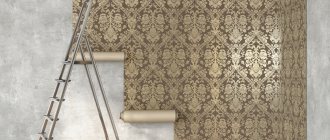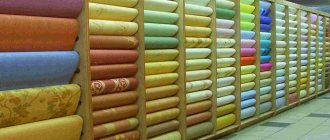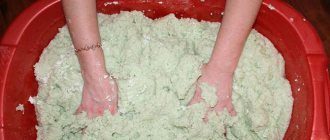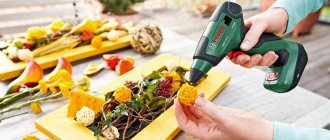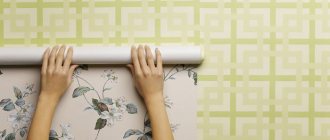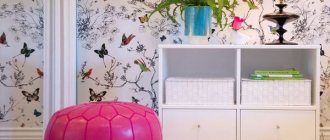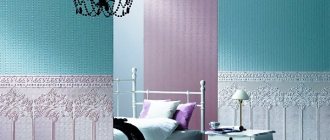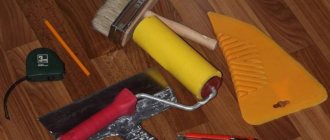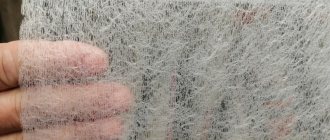Friends, today we will talk about whether it is possible to glue paper wallpaper with non-woven glue and, if so, what nuances exist.
By and large, it is not for nothing that manufacturers differentiate wallpaper according to different criteria, and for these distinctions there are many varieties of glue that is used exclusively for this wallpaper. However, sometimes it happens that after renovating one of the rooms you are left with glue residues, and you still have to glue another room where you chose paper wallpaper as a covering. What to do in this case?
In general, when using glue from non-woven wallpaper for paper wallpaper, you take a risk, because non-woven wallpaper is denser and the glue used for gluing it is more aggressive, since such wallpaper is quite heavy.
Paper wallpapers themselves are quite light and simple, and to glue them you need to use regular paper wallpaper glue.
What can happen when gluing paper wallpaper with non-woven glue?
If you decide to take a risk and glue paper wallpaper with non-woven glue, you may face some consequences.
- Firstly, glue can deform your pattern or texture of paper wallpaper, so when using it you need to take into account some points that we will discuss below.
- Secondly, when gluing wallpaper end to end, as the glue dries, seams may form that will need to be repaired later.
By and large, it is difficult to say exactly how paper wallpaper will react to glue for non-woven wallpaper. What matters here is the density of your paper wallpaper.
- If the wallpaper is very thin and simple, then glue for non-woven wallpaper can be harmful.
- If the paper wallpaper is thick enough, then perhaps everything will go smoothly.
Either way, you're taking a risk.
Paste
You can also make your own wallpaper glue for paper wallpaper. Our grandmothers used it and gave it the name – paste.
Despite its long life, it still retains good performance in reliable, high-quality gluing. A completely worthy alternative to glue: more economical (a godsend for a large amount of work), does not cause allergies, and is environmentally friendly. And it may even have higher and longer-lasting performance properties - last longer and stronger.
Suitable for various surfaces, even for fairly dense fabrics.
The paste can be made from flour or starch. Since the composition is exposed to heat during the preparation process, an enamel or metal container is required.
Flour paste
In the first option, add 200 grams of flour to 200 ml of cold water and mix thoroughly without forming lumps. In a separate saucepan, bring 800 ml water to the boil. Mix with the flour solution and, while stirring, bring it back to a boil. Strain, cool. Use strictly during the day, as the adhesive capacity is quickly exhausted.
Flour of the 2nd and 3rd grades is cheaper and has a higher viscosity. And the heavier the wallpaper, the more flour you need to sprinkle, the stronger the adhesion will be. For light wallpapers, it is wiser to use wheat flour, and for dark wallpapers, rye flour.
To achieve certain properties, auxiliary components are added:
- denatured alcohol, ethyl alcohol, turpentine will increase stickiness;
- Glycerin and gelatin will add elasticity and increase adhesion. The solution can withstand even small tiles.
Starch paste
Starch paste is less popular because it is only suitable for light, light paper. In addition, it can be stored for no more than five hours exclusively in glass containers.
The starch is pre-sifted and added to boiling water over the fire, with constant stirring. When the mass becomes like liquid dough, PVA glue is added to increase the solution’s resistance to moisture. Boil and strain.
Both types of paste are prone to the formation of mold and mildew. For disinfection, copper sulfate is introduced in a ratio of 10 grams per 1 kg of flour or starch.
To increase strength, craftsmen advise adding PVA or wood glue to the pastes. But it must be taken into account that dismantling the wallpaper will be significantly difficult.
What are the nuances when gluing paper wallpaper with non-woven glue?
If you decide to glue paper wallpaper with non-woven wallpaper glue, you need to clarify some points that will help you avoid difficulties.
- Glue for non-woven wallpaper in relation to paper wallpaper must be diluted according to the instructions, and then add a little more water. Those. the glue must be made more liquid if you decide to glue paper wallpaper with it.
- Glue for non-woven wallpaper should be applied exclusively to the wall, and only then apply dry wallpaper sheets to the wall. If you apply glue to the wallpaper itself, during the smoothing process you can deform it and your patterns or textures will not match.
- After gluing the wallpaper, you should not allow drafts so that the glue can dry at its usual temperature conditions.
Reviews
It's time to renovate the hallway. The sales consultant recommended paper-based vinyl wallpaper. For a room such as a hallway, the possibility of wet care is the most important. The room turned out great, the wallpaper was easy to care for. We are happy with our choice.
Alla, Zaraysk
We did the repairs ourselves. We chose vinyl wallpaper with a paper base. They glue quickly, lie flat, without “bubbles” or folds. We tried to glue the strips end to end correctly. I was pleased with the result, the wall looks very nice.
Alexander, Lyubertsy
Wallpaper for the nursery was chosen based on its harmlessness. The most “pro” recommendations were for paper-based vinyl wallpaper. They allow air to pass through well and are washable.
Irina, St. Petersburg
We chose vinyl wallpaper for the living room.
We were worried because the walls in our rooms are not very smooth. They invited a craftsman to do the gluing, but they themselves just watched and were surprised. Once the walls were leveled, the process moved quickly and we soon had a perfect room with no visible seams. The wallpaper adheres evenly and tightly to the walls. For this we purchased a special glue – KLEO. Elena, Samara
How to prepare walls for wallpapering
Of course, preparing walls for wallpapering takes up quite a large place in renovation work.
If your walls are not prepared, the end result may not be what you would like. Therefore, it is worth properly preparing the walls before gluing wallpaper.
- First of all, the walls need to be leveled. Any deviation of the walls from the vertical position is a problem. Subsequently, as soon as you arrange the furniture, especially tall cabinets in the corners, you will have a situation where the cabinet stands strictly vertically, and the seam between the cabinet and the wall is different, due to the fact that the wall has a deviation. It is also worth leveling out any small defects such as bumps or pits. To do this, the walls are primed and then covered with plaster.
- The next step in preparing walls for wallpapering is priming followed by applying putty, which will make your walls as smooth as possible and suitable for decoration.
- Next, you need to clean the walls, smoothing out all the small irregularities that arose during the application of plaster and putty.
- The last step in preparing walls for gluing is applying a finishing primer, which will create a good layer so that the wallpaper sticks confidently to the walls and does not peel off.
Vinyl wallpaper with paper backing
The finishing materials market offers wallpaper of various types:
- multi-colored canvases with printed floral patterns;
- embossed with embossing;
- striped trellises trimmed with gilding or silver.
They are made from traditional materials such as paper or modern ones such as vinyl, non-woven or linkrusta.
Types of vinyl wallpaper
Vinyl wallpaper is a finishing material in which polyvinyl chloride is applied to a paper, possibly non-woven or other base. They are characterized by:
- the ability not to fade in the sun;
- durability (at least 7 years);
- possibility of wet cleaning;
- use in rooms with high humidity (kitchen, bathroom).
There are four types of vinyl material on the market:
- hard (durable and easy to maintain);
- foamed (suitable for uneven walls, this product has excellent breathability);
- silk-screen printing (the upper layers contain silk threads);
- for painting (embossed wallpaper with non-woven base, color – white).
There is an opinion that vinyl trellises may be of dubious quality in terms of safety. At the same time, according to consumer reviews, no health hazard was noted from this material. This applies to both inexpensive and exclusive vinyl trellises.
Vinyl sheets can have different backings, but the most popular is still paper. Numerous reviews in favor of this base are based on the merits of the paper “backing”.
Features of paper wallpaper base
The manufacturer can apply any coating to the paper base, that is, another layer:
- paper or textiles;
- vinyl or non-woven;
- perhaps a traffic jam, etc.
Paper-based wallpaper has the following properties:
- strength;
- waterproof;
- long service life.
All these properties are due to the advantages of the materials used to cover the base. However, you need to understand that the paper base only partially determines the characteristics that the product as a whole will have.
Advantages of canvas with a paper base
- The paper base has a low cost compared to other materials, so it is the most profitable for production.
- Every positive consumer review of vinyl wallpaper with a paper base confirms its excellent breathability and harmlessness.
We also cannot remain silent about the fact that trellises with a paper base still have two significant drawbacks.
- Limitations in scope. Wallpaper with such a base is not recommended for gluing bathrooms and kitchens, since in these rooms there are factors of temperature changes and high humidity. The paper version of the base can lead to deformation of the canvas and, moreover, they may simply fall off the wall.
- It is difficult to glue wallpaper with a paper backing. Firstly, due to the need to apply glue to the “substrate”. Secondly, wallpaper that is wet from glue is difficult to join together, and the fight against air “bubbles” during gluing requires a lot of effort to eliminate them.
That is why gluing vinyl wallpaper on a paper base requires the performer to know how to glue them correctly and have skills in the gluing technique.
What else is worth knowing?
If you decide to glue paper wallpaper with non-woven wallpaper glue, you should understand that if your wallpaper is cheap enough, then it makes sense to save money.
- If your paper wallpaper is expensive, then we do not recommend taking risks, because later if everything goes wrong, you will not be able to correct the situation. You will have to buy new wallpaper and the correct glue for it.
- Even if you decide not to prepare the walls for wallpapering, but to glue them to the walls as they are, you should not ignore the primer layer. The primer creates adhesion by removing excess dust and dirt from the walls. This will help your wallpaper stay on the walls for a long time and not peel off. If you put wallpaper on dirty, dusty walls, then there is a high probability that over time, if not the next day, the wallpaper will come off in some places and will have to be re-glued.
- It is also worth making sure that your wallpaper adhesive is intended specifically for non-woven wallpaper, because there are also universal adhesive compositions that are quite suitable for gluing wallpaper of any type and density.
The best adhesives for glass wallpaper
Glue for glass wallpaper is presented in ready-made and bulk form. The main requirement for such a product is a high degree of adhesion and viscosity, since the glass material is very heavy. It’s good if the adhesive composition is frost-resistant, plus it must contain PVA components. This category presents two nominees who became the best thanks to user ratings.
Oscar Sukhoi
Oscar is intended only for fiberglass wallpaper. It is presented in a simple cardboard box (400 g), designed for 50 sq/m and has low consumption. It dissolves in water quite quickly, after mixing it can be used within five minutes. The consistency is thick, viscous, it does not flow from the brush and has a transparent color. The glue itself does not impregnate the fiberglass and does not cause yellowing, streaks or stains on the wallpaper. While the product dries, you can adjust it a little without fear that shiny streaks will remain. Customers also consider frost resistance to be an advantage of Oscar - even at high temperatures it does not freeze.
Advantages
- Suitable for any surfaces (concrete, wood);
- Anti-mold and antifungal components;
- Resistant to humidity and temperature changes;
- Easy to apply.
Flaws
- Takes a long time to dry;
- The prepared solution is not stored for long.
Experts recommend diluting oscar glass wallpaper glue strictly according to the instructions and observing the temperature conditions in the room being glued.
Norme Color
Norme Color is suitable even for frescoes, fiberglass and fabric wallpaper; the adhesion of this product is very high. It is sold ready-made, packaged in 10 kg buckets and does not contain solvent. The composition includes a thickener, acrylic latex and an antiseptic, which prevents the formation of microorganisms on the surface. The components also include water and special technological additives that provide reliable adhesion. Moreover, the glue is absolutely odorless, it is harmless to people and animals, and is easily washed off with warm water. Also, the adhesive mixture does not leave stains on the surface of the wallpaper and does not flow, so it is easy to apply.
Advantages
- Dries quickly;
- Economical consumption;
- Fireproof;
- Neutral to low temperatures;
- Preserves the relief pattern.
Flaws
- Difficult to find on sale;
- High price.
Buyers give this nominee the highest score, and experts note that the price for a package of Norm Color is very high. Despite this, it is in great demand and is considered one of the best building materials on the market.
Conclusions on the topic
So, today we looked at the topic of whether it is possible to glue paper wallpaper with non-woven glue and what are the nuances when gluing. It’s worth saying at the end once again that the final result of your activity cannot be predicted, because different paper wallpapers will behave differently if they are glued with non-woven glue. This is all an experiment and nothing more. If you decide to do it, then just understand the points that you should pay attention to when wallpapering. At the very least, if you follow our instructions, you will minimize the deformation of the wallpaper when gluing and when the adhesive composition dries.
If you still have questions on the topic, you can ask them in the comments to this article. Also, if you have conducted similar experiments, please share your results. How did your paper wallpaper behave after gluing it with non-woven glue? Also tell us about the gluing technology to confirm or refute our recommendations and give additional advice to other experimenters.
Good luck with your renovation!
What is the best way to glue overlap or butt?
The choice between “butt” or “overlapping” depends on the thickness of the wallpaper. For thin specimens, it is necessary to use a technique to form an edge seam - after all, after drying, the edges of the canvases will begin to diverge, and if glued end-to-end, a gap will form.
Medium and thick samples do not have a tendency to dry out. Moreover, overlapping placement will result in a very visible edge band that will attract unnecessary attention.
